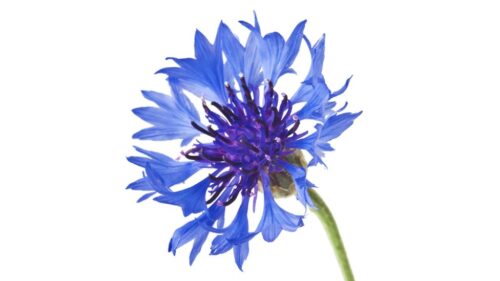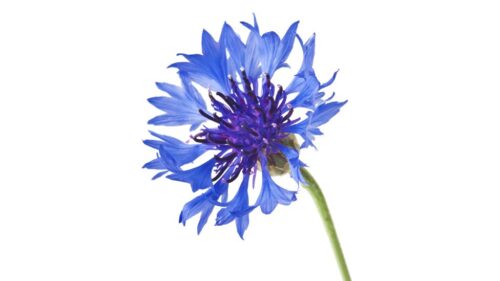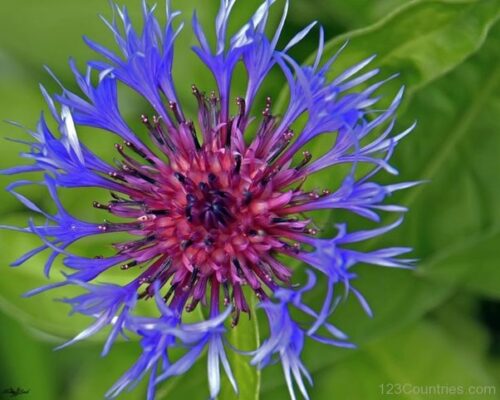Germany’s national flower is the cornflower, known for its vibrant blue color and strong symbolism in German culture. The cornflower has been a symbol of romanticism, freedom, and prosperity in German folklore and history for centuries.
Its vivid blue petals have been associated with loyalty, love, and hope. The flower’s resilience and ability to thrive in various conditions mirror the characteristics of the German people and their unwavering spirit. The cornflower has also been linked to German resistance movements and has been adopted as a symbol of remembrance for fallen soldiers.
Its significance in German culture and history has made it a beloved emblem and a representation of national pride and identity. The cornflower’s enduring symbolism continues to inspire art, literature, and folk traditions in Germany, showcasing its lasting impact on the country’s cultural heritage.
History Of The Cornflower
The cornflower, also known as “knapweed” or “bachelor’s button,” is Germany’s national flower and holds significant cultural symbolism.
Origin And Early Use
Originally native to Europe, Asia, and North Africa, the cornflower has been cultivated since ancient times.
- A symbol of love and fidelity, cornflowers were often used in traditional herbal medicine.
- With its vibrant blue hue, the flower gained popularity for decorative purposes in the Middle Ages.
Symbolism In German Culture
In German folklore, the cornflower is associated with purity, luck, and protection.
- Representing the unity of the nation, cornflowers have been used in national symbols and emblems.
- During the Romantic era, the cornflower was celebrated for its simple beauty and resilience.
Physical Characteristics
The cornflower, Germany’s national flower, features distinct Physical Characteristics.
Appearance
The cornflower is a slender, upright plant with stiff stems and deep blue flowers.
Growing Conditions
- Germination period: 7-21 days
- Optimal soil: well-drained, sandy loam
- Light requirements: full sun
- Watering: regular, avoid overwatering
- Temperature: thrives in moderate climates
Cultural Significance
Germany’s national flower, the cornflower, holds great cultural significance with its vibrant blue hue representing luck, fortune, and unity in German folklore. This iconic flower symbolizes the country’s rich history, making it a cherished emblem in traditions and celebrations.
The cornflower, also known as Centaurea cyanus, holds great cultural significance in Germany. This delicate and vibrant blue flower has been embraced as a national symbol, representing various aspects of German culture and history. Its cultural significance can be traced back through a rich tapestry of historical associations, folklore, and legends. Let’s explore the deep-rooted meanings and stories behind Germany’s national flower, the cornflower.Historical Associations
Throughout history, the cornflower has been intertwined with German traditions and heritage. One notable historical association of the cornflower dates back to the Romantic era of the 19th century when it became a symbol of nationalism and unity. The blue color of the cornflower was seen as a representation of freedom and independence. During this time, the cornflower was embraced by poets, writers, and artists who used it as a patriotic emblem, emphasizing the beauty and strength of the German nation.Folklore And Legends
In addition to its historical associations, the cornflower is also steeped in folklore and legends. One popular legend surrounds the belief that wearing a cornflower would grant the wearer clairvoyant powers, allowing them to see into the future. The enchanting folklore surrounding the cornflower adds a touch of mysticism to its cultural significance. Another fascinating legend is that during the medieval period, knights would wear cornflowers on their armor or helmets as a symbol of chivalry and honor. This tradition further solidified the cornflower’s association with bravery and nobility.Symbolism
The cornflower’s symbolism extends beyond its historical and mythical associations. It is often regarded as a reflection of simplicity, sincerity, and endurance. The unassuming yet striking appearance of the cornflower resonates with the resilient and modest nature of the German people. It serves as a symbol of the nation’s values such as hard work, perseverance, and integrity. Moreover, the cornflower is closely associated with the agricultural heritage of Germany, representing the country’s rural landscapes and farming traditions. This connection to the land and its significance in agriculture further strengthens the cultural symbolism of the cornflower. Overall, the cornflower holds a special place in German culture, symbolizing nationalism, loyalty, chivalry, simplicity, and endurance. Its historical associations, folklore, and legends have shaped its cultural significance, making it a cherished emblem of Germany’s rich heritage.
Credit: www.bbc.com
National Symbol
The National Symbol of a country holds great significance, representing its values, culture, and heritage. Germany’s National Flower, the cornflower, is deeply rooted in the country’s history and symbolism. Let’s explore how this delicate bloom became a cherished national symbol.
Adoption As Germany’s National Flower
The adoption of the cornflower as Germany’s National Flower traces back to the 14th century, where it gained popularity for its vibrant blue hue and resilience. In 1891, the cornflower was declared as a national symbol, embodying the romantic ideals of the country and symbolizing unity and prosperity.
Symbolism In National Events
The cornflower has become an emblematic presence in various national events and traditions, symbolizing the spirit of the German nation. Its radiant blue petals have been linked to the country’s landscape, expressing the beauty and purity of its natural surroundings. This resonates strongly in festivals, where the cornflower is displayed as a symbol of national pride and resilience.
Cornflower In Art And Literature
Germany’s national flower, the cornflower, has been a recurring motif in the country’s art and literature, symbolizing romanticism, nationalism, and remembrance. Artists and writers often used the vibrant blue hue of the cornflower to evoke feelings of unity and nostalgia, making it a powerful cultural symbol in German history and heritage.
The Cornflower, designated as Germany’s national flower, has long been an inspiration for artists and writers. Its delicate blue petals and rich symbolism have made it a popular motif in art and literature. Let’s explore how the cornflower has been depicted in both paintings and literary works. “`htmlDepictions In Paintings
“` The Cornflower has often been portrayed in paintings as a symbol of purity and patriotism. Artists have captured its vivid blue color and delicate petals in a myriad of ways, showcasing its natural beauty and significance. Through these depictions, the cornflower has become an enduring symbol of Germany’s cultural heritage. “`htmlCornflower In Poetry And Prose
“` Poets and authors have been equally captivated by the cornflower’s allure, using it as a powerful symbol in their works. From verses exalting its vibrant hue to prose exploring its metaphorical meanings, the cornflower has been celebrated for its evocative symbolism. Its presence in literature reflects its deeper significance as a cultural emblem. In art and literature, the cornflower stands as a poignant symbol, representing the rich heritage and cultural identity of Germany. Artists and writers have found inspiration in its timeless beauty, infusing their works with its enduring symbolism.
Credit: www.bbc.com
Conservation Efforts
The conservation of Germany’s national flower, the cornflower, is of utmost importance. Protection and preservation efforts are crucial to ensure the survival of this beautiful and symbolic flower.
Protection And Preservation
To protect the cornflower and preserve its natural habitat, various initiatives and measures are being undertaken.
- 1. Raising Awareness: Educational campaigns and awareness programs play a vital role in informing the public about the significance of the cornflower and the need to protect it.
- 2. Conservation Areas: Designating specific areas as conservation zones helps safeguard the cornflower’s unique ecosystem, ensuring its preservation for future generations.
- 3. Strict Legislation: Enacting and enforcing strict laws and regulations is essential to prevent the destruction of cornflower habitats and the illegal trade of this precious flower.
- 4. Research and Monitoring: Conducting scientific research and continuous monitoring allows experts to assess the cornflower population’s health, identify threats, and implement appropriate conservation measures.
Threats To The Cornflower
Despite ongoing conservation efforts, the cornflower faces several threats that need to be addressed promptly.
- Habitat Loss: The destruction and fragmentation of natural habitats due to urbanization, agricultural expansion, and industrial development pose a significant threat to the cornflower’s survival.
- Invasive Species: The introduction of invasive plant species competes with the cornflower for resources, hampers its growth, and disrupts its natural balance.
- Herbicide Use: Excessive use of herbicides in agricultural practices can result in the unintended destruction of cornflower populations and other beneficial wildflowers.
- Climate Change: Alterations in temperature, precipitation patterns, and other climatic factors can affect the cornflower’s blooming periods, seed production, and overall reproductive success.
- Illegal Harvesting: Unregulated harvesting for commercial purposes is a severe threat that puts immense pressure on cornflower populations, potentially leading to their decline.
Medicinal And Culinary Uses
The cornflower, Germany’s national flower, holds both medicinal and culinary significance. Renowned for its blue hue, this flower is often used in traditional German cuisine and herbal medicine. Its symbolism as a representation of hope and unity reaffirms its cultural importance.
The cornflower, Germany’s national flower, has a rich history of medicinal and culinary applications. Let’s explore the traditional medicinal uses and culinary uses of this beautiful flower.Traditional Medicinal Applications
– Historically, cornflowers were used to treat eye infections and inflammation. – The flower was believed to have anti-inflammatory and astringent properties. – Cornflower tea was popular for its ability to relieve fever and soothe coughs. – In traditional medicine, cornflowers were often used to address digestive issues.Culinary Uses
– Cornflowers have been used in culinary creations to add a splash of color. – They are commonly used to decorate pastries, salads, and drinks. – Cornflowers are also edible and can be added to dishes for a subtle floral flavor. – Cornflower syrup is a popular choice for sweetening desserts and beverages.Gardening And Home Decor
Gardening and Home Decor: The cornflower, Germany’s national flower, adds a touch of elegance and charm to gardens and home decor. Let’s explore how you can incorporate the beauty of cornflowers into your living spaces.
Cornflower Varieties For Gardens:
- Blue Boy: Known for its vibrant blue petals.
- Classic Romantic: Delicate pink varieties for a subtle touch.
- Black Ball: Dark, almost black petals for a unique look.
Incorporating Cornflowers In Home Decor:
- Vase Arrangements: Display freshly picked cornflowers in a vase for a pop of color.
- Wall Art: Frame dried cornflowers to create stunning botanical wall art.
- Pillows and Throws: Adorn your living room with cornflower-themed pillows and throws.
- Table Settings: Use cornflowers as table decorations for a charming dining experience.
- Scented Candles: Enjoy the aroma of cornflower-scented candles in your home.
Cornflower Festivals And Events
The Cornflower is a symbol of German cultural heritage and has inspired many festivals and events celebrating its significance. Across Germany, various Cornflower Festivals are held, each offering a unique experience filled with tradition and joy.
Celebrations And Contests
Local communities organize celebrations where people come together to admire the beauty of Cornflowers. Visitors can participate in contests showcasing their knowledge about this national flower.
Cornflower Parade
One of the highlights of these festivals is the Cornflower Parade, where colorful floats adorned with Cornflowers parade through the streets, accompanied by music and dancing.
Cornflower In Agriculture
Introduction: Discover the significance of the Cornflower in Agriculture, a symbol deeply rooted in German culture and history.
Crop Rotation Benefits
Cornflowers in crop rotation maintain soil health by breaking pest cycles and improving nutrient retention.
- Prevent Soil Depletion: Cornflowers enhance soil fertility naturally.
- Combat Pests: Their presence reduces the need for chemical pesticides.
Using Cornflowers As Companion Plants
Interplanting with cornflowers attracts beneficial insects, promoting ecological balance in agricultural settings.
- Attract Pollinators: Bees and butterflies are drawn to cornflowers, aiding in pollination.
- Suppress Weeds: These flowers outcompete weeds, reducing the need for herbicides.
Endangered Status And Conservation Efforts
The cornflower, also known as “Knapweed” or “Bachelor’s Button,” holds a special place in German culture as the national flower. However, its existence is under threat due to various factors, leading to conservation efforts to protect and preserve this symbol of national pride.
Threats To The Cornflower
The cornflower faces numerous threats, including habitat loss due to urbanization and agricultural expansion, as well as the use of herbicides in modern farming practices. Additionally, the decline of traditional agricultural practices and the rise of monoculture farming have impacted the natural habitats of the cornflower, leading to a decrease in its population.
Conservation Initiatives
To combat the declining population of cornflowers, several conservation initiatives have been put in place. Governments and environmental organizations are working to protect and restore the natural habitats of the cornflower, implementing measures to reduce the use of harmful herbicides and promote sustainable farming practices. Furthermore, public awareness campaigns are being conducted to educate people about the importance of preserving the natural environment and its biodiversity.

Credit: www.quora.com
Cornflower In Traditional Folklore
Germany’s national flower, the cornflower, holds deep significance in traditional folklore. Known for its vibrant blue hue, the cornflower is admired for its representation of luck, fertility, and protection from evil spirits. It has been cherished in German culture for centuries as a symbol of national pride and resilience.
Myths And Superstitions
The Cornflower, often referred to as “Bachelor’s Button” or “Bluebottle,” holds a special place in traditional folklore in Germany. Passed down through generations, various myths and superstitions have emerged surrounding this enchanting flower. According to one popular myth, it is believed that placing a Cornflower under your pillow can bring you vivid dreams and protect you from nightmares. This superstition originated from the belief that the Cornflower possesses magical properties that can ward off evil spirits and ensure restful sleep. Another widely held belief is that wearing a Cornflower in your hair or as a boutonniere can bring good luck and protection against the “evil eye.” The “evil eye” refers to the malevolent stare believed to cause harm or misfortune to those it targets. By wearing the Cornflower, individuals sought to shield themselves from such negative energies.Symbolic Meanings
The Cornflower carries deep symbolic meanings in German folklore. One of the most prominent interpretations is that the flower represents fidelity and everlasting love. This symbolism is rooted in a tale of two young lovers who vowed to be faithful and never part ways. As a symbol of their undying devotion, they exchanged Cornflowers before parting. Since then, Cornflowers have come to symbolize loyalty and commitment in relationships. Another symbolic meaning associated with the Cornflower is resilience and endurance. The Cornflower, with its vibrant blue petals, is known to flourish even in harsh conditions. This attribute has led to the flower being seen as a symbol of strength, perseverance, and the ability to thrive against all odds. In addition to its symbolic meanings, Cornflowers also hold historical significance in Germany. During the 19th century, the flower became a symbol of German nationalism due to its blue color, which closely resembles the shade of the Prussian military uniform. Cornflowers were worn to show support for the cause of a united Germany. In conclusion, the Cornflower holds a special place in German folklore with its plethora of myths and superstitions. Its symbolic meanings of fidelity, resilience, and national pride have made it a cherished and revered flower in German culture. From warding off evil spirits to representing everlasting love, the Cornflower continues to captivate hearts and minds as an iconic national symbol.Frequently Asked Questions Of Germany’s National Flower: The Cornflower And Its Symbolism
What Is Germany’s National Flower?
Germany’s national flower is the cornflower (Centaurea cyanus), cherished for its deep blue color and cultural significance.
What Is The Symbolism Of The Cornflower?
The cornflower symbolizes unity, peace, freedom, and resilience in German culture and history.
Why Is The Cornflower Important In Germany?
The cornflower holds historical significance in Germany, representing the country’s national identity and cultural heritage.
How Does The Cornflower Grow In Germany?
Cornflowers thrive in Germany’s diverse landscapes, flourishing in meadows, fields, and along roadsides, known for their resilience and adaptability.
What Are The Traditional Uses Of The Cornflower?
Traditionally, cornflowers have been used for medicinal purposes, in culinary arts, and as a symbol in art and literature.
How Does The Cornflower Contribute To Biodiversity?
Cornflowers play a vital role in supporting biodiversity, attracting pollinators and enriching the ecosystems where they grow.
Can I Cultivate Cornflowers In My Garden?
Absolutely! Cornflowers are easy to cultivate in gardens, adding a delightful splash of blue and contributing to local biodiversity.
Conclusion
The Cornflower holds great significance as Germany’s national flower. Its vibrant blue hue represents hope, purity, and loyalty, which aligns with the values and resilience of the German people. The flower’s historical significance, coupled with its symbolic meanings, make it a cherished and beloved emblem of German culture.
Celebrated for its beauty and admired for its symbolism, the Cornflower truly embodies the spirit of Germany.
